 |
 |
 |
 |
 |
 |
 |
 |
 |
| Ghettos |
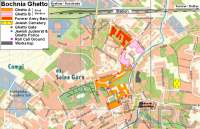 |
| Ghetto Map |
On the outbreak of WW2, an estimated 3,500 Jews lived in Bochnia, representing about 20% of the total population. The town was occupied by the Germans on 3 September 1939, after heavy air raids on the town and the Rakowice Airfield. Immediately the exploitation of the Jewish population common to all of subjugated Poland began. In the autumn of 1939 a Jewish Committee was formed on the initiative of Samuel Freudenhheim. On 1 December 1939, the edict requiring Jews to wear a white armband bearing a blue Star of David had been introduced, and in May 1940 an enormous “fine” of 3 million zloty was demanded from the Jewish population. 200-300 young Jews were sent to the Pustkow labour camp, near Debica, in mid 1940, and at the end of that year deportation of young Jewish men to the labour camp at Klaj, 12 km west of Bochnia, began.
In December 1940, the Jewish Committee was transformed into a Judenrat with Symcha Weiss, the owner of a shoe store, as its chairman. At about the same time, a Jewish Police Force (Ordnungsdienst) was created, headed by Dr Szymon Rosen, a lawyer. Both the Judenrat and the Ordnungsdienst had their quarters at 13 Niecala Street.
 |
| Städtische Werkstätten Workshop * |
At the end of 1941, a Jewish hospital with 45 beds was established, located on Solna Gora. Various workshops were also set up, employing some 2,000 people. The largest of these, located on Floris Street in the “red brick building”, produced uniforms for the German Army, while other workshops manufactured underwear, shoes, and brushes. There were also locksmiths, box-makers, and carpenters, among other trades. The workshops were headed by a German, Wettermann, and supervised by a Jew, Salomon Greiwer. These enterprises were sufficiently successful for production to be expanded into the neighbouring ghetto in Wieliczka and to the Jewish community of Wisnicz.
Following the order of 18 May 1940 concerning the expulsion of Krakow Jews, a large group from this city settled in Bochnia. In March 1941, 500 Jews from Krzeszowice arrived, and in spring 1942 a further large group from Mielec.
The first deportation from the Bochnia Ghetto took place on 16 April 1942, when 204 Jews were taken to a labour camp. For this deportation the Judenrat was charged the sum of 7,000 zlotys.
 |
| The Wisnicz Jewish Community marching to Bochnia * |
 |
| Selection at the Army Barracks * |
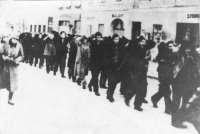 |
| Marching to the Execution * |
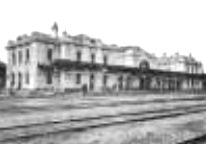 |
| Bochnia Station |
Virtually the entire Judenrat was sent to Belzec in the last transport of the first Aktion. Officially, there were about 1,000 Jews left in the ghetto, with a further estimated 400 “unofficials” in hiding. Believing that the Aktion in Bochnia was over, thousands of Jews from the vicinity came out of hiding and began to arrive at the ghetto. The chief Gestapo officer in Bochnia, Schömburg, published a special permit for all of the Jews who had concealed themselves, allowing them to live in the Bochnia Ghetto. All of the workshops were reopened. The number of Jews residing in Bochnia grew to 8,000, with the number of Jews employed in the workshops swelling to 3,000. The status of the Bochnia Ghetto was changed to that of a labour camp, with SS-Obersturmführer Müller as the new Lagerführer.
On 24 September 1942 the Germans conducted a round-up in the ghetto. Able-bodied men unable to produce worker's permits were arrested. A group of 100 men were sent to the Rakowice (Rakowitz) labour camp (near Krakow), a heavily guarded military airfield surrounded by a barbed-wire fence. During the winter of 1942, after the work assigned for the camp's inmates was completed, the camp was liquidated and all Jewish prisoners were sent for extermination, possibly to Auschwitz.
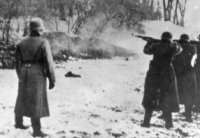 |
| Execution * |
A fence divided the two sections. Those with workers' permits were located in "Ghetto A" and the non-able bodied, elderly, disabled, children, and all people without a worker’s permit were housed in "Ghetto B". The meaning of this division was clear. Residence in "Ghetto A" gave hope for survival, while the residents of "Ghetto B" were doomed. Desperate people used their last money to pay enormous sums in order to acquire the right to work. The labour force was organized into three divisions: Wehrmacht (the armed forces), Rüstung (weapons industry), and Zwangsarbeit (forced labour).
In addition to their Jewish identification armband on the right arm, the workers bore a white worker patch on their left arm carrying either the letter "W", "R" or "Z".
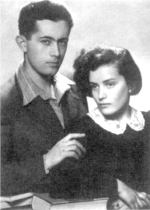 |
| Szymon and Gusta Dränger |
Under the auspices of Zionist organizations, a number of kibbutzes had been set up in pre-war Poland to train young people in agricultural techniques prior to their hoped-for settlement in what was then Palestine. Despite the German occupation, these kibbutzes continued to exist until late 1943. In winter 1942/43, the Jewish Fighting Organisation was formed in Krakow by young people (including the famous couple Szymon and Gusta Dränger, as well as Hilel Wodzislawski and Jozef Wulf, among others) from the Akiba movement. The Organisation began to edit the underground weekly publication HeChaluc HaLochem in Kopaliny kibbutz near Bochnia in May 1942. There were at least 33 editions of the newspaper published until October 1943. The attempt of the movement to organize the mass escape of Jews from the Bochnia Ghetto, during the "September Aktion", failed.
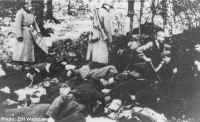 |
| Execution Site* |
Again, approximately 60 people were shot at the communal cemetery at Solna Gora and their bodies cremated. The remainder, consisting of about 1,000 younger people were transferred to the camp at Szebnie. Few of them were to survive. A survivor, Dov Landau, described the Szebnie camp:
“It was a camp that was erected probably a year before that. In this camp we found Jews from different places: from Tarnow, from Krosno and its vicinity, there were people from Mielec, from Ropczyce. All the Jews that remained after ghetto liquidations were brought to this labour camp… It was fenced all around with a fence that might have been electrical fence. Anyway it was a double barbed wire fence with watch towers and guard dogs around it. On the outside I saw some huts that probably served as the residence for the camp guards… In the whole camp there were about ten thousand people. Men women and children. There were children of different ages from ten years of age and up. I was considered a big boy there, I was fifteen years old.”
150 Jews were left in Bochnia to clear the ghetto area. After six weeks, 100 of this group were taken to the Szebnie camp. The remainder continued working until December, when they were transferred to KL Plaszow. In the weeks following the liquidation of the ghetto, approximately 500 Jews who had been in hiding in the town were discovered. They were immediately taken to the Jewish cemetery and shot.
It is estimated that approximately 15,000 Jews were deported from Bochnia, with at least a further 1,800 killed in the town and its surroundings.
About 90 Jews from Bochnia survived the war, either in hiding, in camps or in the Soviet Union. Most of them immigrated to the USA, Belgium, and Israel.
Trials:
Kiel, 1968-69:
Heinrich, Hermann - proceeding suspended
Müller, Franz Josef – acquittal
(Polizei Sipo Krakau, Haftstättenpersonal ZAL Bochnia)
Crimes committed in 1942-43, Krakau, Bochnia, Wieliczka, HS ZAL Plaszow:
Deportations to KL Belzec and Auschwitz. Single and mass killings of Jews;
Kiel, 1970:
Müller, Franz Josef - 12 years
(Haftstättenpersonal - Detainment Center Staff, ZAL Bochnia)
Crimes committed in 1942-44:
Liquidation of the Bochnia Ghetto. Single shootings of Jews and selections within the forced labour camp of Bochnia.
Photos:
GFH *
ZIH Warszawa *
Archiwum Panstwowe w Krakowie Oddzial w Bochni *
Sources:
www.angelfire.com
http://motlc.learningcenter.wiesenthal.org
Arad, Yitzhak. Belzec, Sobibor, Treblinka - The Operation Reinhard Death Camps, Indiana University Press, Bloomington and Indianapolis, 1987
Justiz und NS-Verbrechen - Nazi Crimes on Trial - www1.jur.uva.nl
Zawidzka, Irena. W 50 rocznice zaglady getta bochenskiego, in: Rocznik Bochenski, vol.I; Bochnia, 1993
Szymkowska, Maria. Bochenskie getto. Wiadomosci bochenskie, no. 3/2002
© ARC 2005